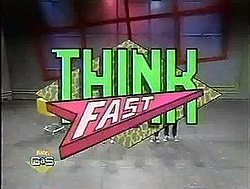Think Fast!
| Think Fast | |
|---|---|
 |
|
| Genre |
Children's game show Comedy |
| Created by | Bob Mittenthal Michael Klinghoffer |
| Developed by | Geoffrey Darby Michael Klinghoffer Robert Mittenthal Herb Scannel Byron Taylor |
| Directed by | Lexi Rae (1989–1990) Bob Lampel (1990–1991) |
| Presented by |
Michael Carrington (1989–1990) Skip Lackey (1990–1991) |
| Narrated by | James Eoppolo (1989–1990) Henry J. Waleczko (1990–1991) |
| Composer(s) | Edd Kalehoff |
| Country of origin | United States |
| No. of seasons | 2 |
| No. of episodes | 106 |
| Production | |
| Executive producer(s) | Geoffrey Darby (1989–1991) Michael Klinghoffer (1990–1991) |
| Producer(s) | Robert Mittenthal (1989–1990) Marjorie Cohn (1990–1991) |
| Location(s) |
WHYY-TV Studios Philadelphia, Pennsylvania (1989–1990) Universal Studios Orlando, Florida (1990–1991) |
| Release | |
| Original network | Nickelodeon |
| Original release | May 1, 1989 – June 29, 1991 |
Think Fast is an American children's game show which aired on Nickelodeon from May 1, 1989 to June 29, 1991.
For the first season, the show was hosted by Michael Carrington, and announced by James Eoppolo. When the show moved to the new Nickelodeon Studios in Orlando, Florida for season two, Carrington was replaced by Skip Lackey. While Eoppolo was invited to stay on as announcer, he was contractually obligated to another project by that time, and was replaced by Henry J. Waleczko. The show's theme music was composed by Edd Kalehoff.
Two teams of two (one of them wearing gold, another wearing blue) competed in various events that would "boggle the mind as well as the bodies". The team that completed each stunt won money ($50 for Round 1, $100 for Round 2). In the Carrington era, it was possible for some events to end in a draw, whether by both teams failing to complete a stunt, or by a tie score. When both teams failed, no money was awarded to either team; with a tie score, the money was awarded to each team. Also in the Carrington era, some events required a team to buzz in when they were done; if a team buzzed in without completing the event properly, the other team won.
After each event, the winners of the event in addition to the cash won a chance to solve a visual puzzle known as the "Brain Bender". In each attempt a puzzle piece was removed. The puzzle could be a picture of a celebrity, a rebus, a close-up object or objects in common. Correctly solving a Brain Bender was worth $200. If the Brain Bender was solved in the first round, another one was started in the second half, still worth $200. If nobody solved the Brain Bender after the final event, or if a tie occurs at the end of the game, a sudden death showdown was played. Originally teams alternated turns taking guesses after each puzzle piece was removed; in later episodes, pieces were removed one at a time until one player buzzed in with a correct answer. Generally speaking, who ever solved the Brain Bender-won the game. On very early episodes if the puzzle was solved early in the first round, a second Brain Bender was thrown out. Usually, this puzzle was so hard or obscure, it couldn't be solved. When the Brain Bender was objects in common, a different version of the Brain Bender was used in which one of six pictures or drawings was revealed after every event. The teams had to guess what the depicted items all had in common.
...
Wikipedia
